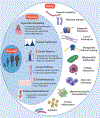Aging in Heart Failure: Embracing Biology Over Chronology: JACC Family Series
- PMID: 38597865
- PMCID: PMC11331491
- DOI: 10.1016/j.jchf.2024.02.021
Aging in Heart Failure: Embracing Biology Over Chronology: JACC Family Series
Abstract
Age is among the most potent risk factors for developing heart failure and is strongly associated with adverse outcomes. As the global population continues to age and the prevalence of heart failure rises, understanding the role of aging in the development and progression of this chronic disease is essential. Although chronologic age is on a fixed course, biological aging is more variable and potentially modifiable in patients with heart failure. This review describes the current knowledge on mechanisms of biological aging that contribute to the pathogenesis of heart failure. The discussion focuses on 3 hallmarks of aging-impaired proteostasis, mitochondrial dysfunction, and deregulated nutrient sensing-that are currently being targeted in therapeutic development for older adults with heart failure. In assessing existing and emerging therapeutic strategies, the review also enumerates the importance of incorporating geriatric conditions into the management of older adults with heart failure and in ongoing clinical trials.
Keywords: aging biology; geriatrics; heart failure.
Copyright © 2024 American College of Cardiology Foundation. Published by Elsevier Inc. All rights reserved.
Conflict of interest statement
Funding Support and Author Disclosures Dr Goyal has received grant support from National Institutes of Health (NIH) grants K76AG064428 and R21AG077092; and has received personal fees from Sensorum Health, Agepha Pharma, and Axon Therapies. Dr Maurer has received grant support from NIH grants R01HL139671 and R01AG081582-01; has received grants and personal fees from Alnylam, Pfizer, Eidos, Prothena, and Ionis; and has received personal fees from AstraZeneca, Akcea, Intellia, and Novo Nordisk. Dr Roh has received grant support from NIH grants K76AG064328 and R01HL170058, Hassenfeld Scholars Award, MGH Transformative Scholars Award, and the Fred and Ines Yeatts Fund for Innovative Research; and has received research support from Genentech, Amgen, and Keros Therapeutics.
Figures


References
-
- Tsao CW, Aday AW, Almarzooq ZI, et al. Heart disease and stroke statistics-2023 update: a report from the American Heart Association. Circulation. 2023;147:e93–e621. - PubMed
-
- Lopez-Otin C, Blasco MA, Partridge L, Serrano M, Kroemer G. Hallmarks of aging: an expanding universe. Cell. 2023;186:243–278. - PubMed
Publication types
MeSH terms
Grants and funding
LinkOut - more resources
Full Text Sources
Medical
Research Materials

